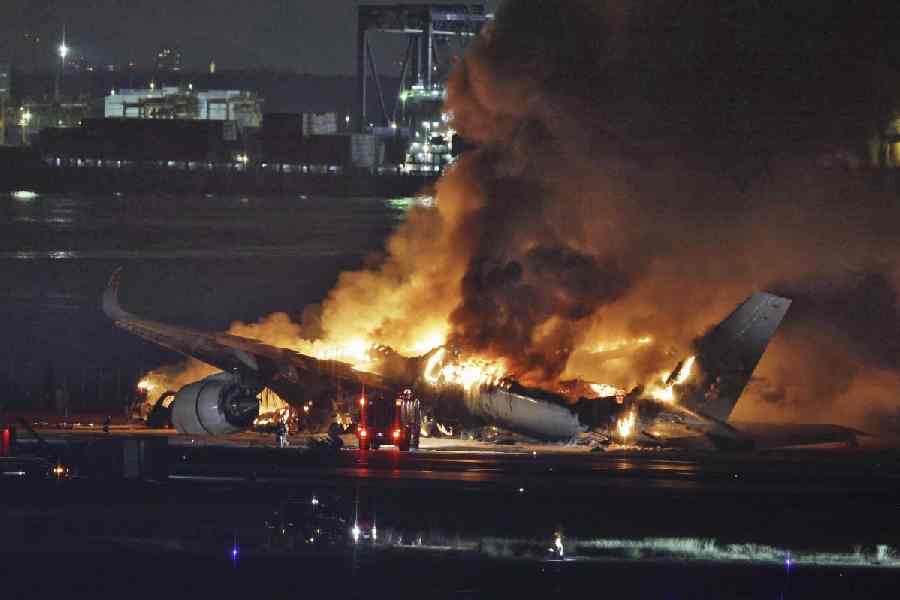The cabin crew of the Japan Airlines aircraft that collided with another plane and burst into flames at Tokyo's Haneda Airport did an "incredible job" by quickly evacuating all 367 passengers, an expert said Tuesday, highlighting the importance of training.
All 379 people on JAL flight 516, including eight children under the age of two, were safely evacuated from the burning passenger plane, according to the airline. However, five people on the second aircraft, flight MA-722, a Bombardier DHC8-300, operated by the Japan Coast Guard, were killed in the rare aviation accident in Japan. The captain of the Japan Coast Guard plane escaped but was severely injured.
The JAL plane was arriving from New Chitose Airport in Hokkaido, with the collision occurring after it landed on runway C.
The coast guard aircraft was on a mission to fly to a base in Niigata Prefecture carrying supplies to support the area affected by the deadly 7.6 magnitude earthquake that hit central Japan on Monday. The coast guard aircraft was moving on the runway when it collided with the JAL plane, The Japan Times newspaper reported.
Prof Graham Braithwaite, director of transport systems at Cranfield University in the UK, praised efforts made by the cabin crew and pilots onboard the Japanese Airlines flight.
"Japan has a phenomenal record when it comes to transport safety," Prof Braithwaite told the BBC as he described JAL as a "world leader" in safety.
"The evacuation has been successful and it is a reminder of how much has gone into training cabin crew.
"Their focus is on safety. They are the last people to evacuate the airplane and on face value, it looks like they have done an incredible job," he said.
Speaking to reporters, officials from Japan's transport ministry and coast guard said they were still in the process of confirming specific flight control communications between the JAL plane, the coast guard aircraft and air traffic controllers.
“I have never heard of such a major collision at an airport in Japan,” said Yoshitomo Aoki, an aviation analyst, quoted as saying by The Japan Times newspaper.
“The world's air traffic control systems are designed to prevent accidents as long as air traffic controllers at airports issue correct instructions and pilots follow them,” Aoki said.
The passengers and the crew aboard JAL's plane escaped the burning aircraft using emergency slides, Kyodo news agency quoted the transport ministry as saying.
Uchida, a passenger in her 40s from Chiba Prefecture who only gave her surname, was sitting in a window seat on the right side of the plane near the wing.
She said that when the plane landed, it made a loud noise, but she didn’t realise there had been a collision, initially thinking they had landed safely. But after looking out the window, she saw flames near the wing.
“I thought it was over,” she said. “I thought I was about to die,” she was quoted as saying by The Japan Times.
Uchida said passengers were told to remain calm by the cabin crew and that it took a couple of minutes before the plane doors opened, allowing everyone to evacuate. She said she heard a crackling noise after she left the aircraft and feared something would explode.
After exiting from the burning aircraft, Uchida said passengers were counted in an area away from the plane. They were asked to hold hands in groups of ten and to sit down and wait.
The accident happened during one of the busiest travel periods of the year, with millions of Japanese travelling to and from their hometowns for the New Year’s holidays.
Haneda is Japan’s busiest airport, serving nearly 90 million passengers in 2019, prior to the outbreak of COVID-19. It’s a hub for Japan Airlines, All Nippon Airways and several smaller airlines, The Japan Times report said.
Japan’s aviation sector has a strong safety record, with no fatal incidents involving a commercial aircraft this century, it said.
Except for the headline, this story has not been edited by The Telegraph Online staff and has been published from a syndicated feed.











